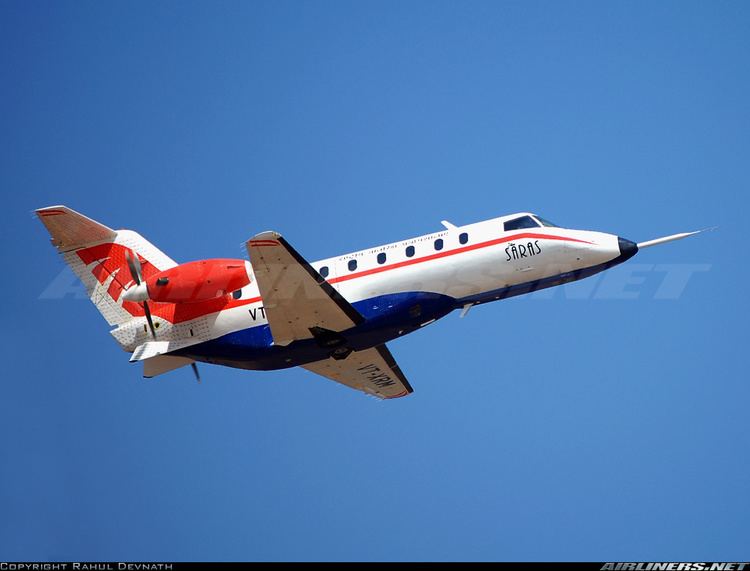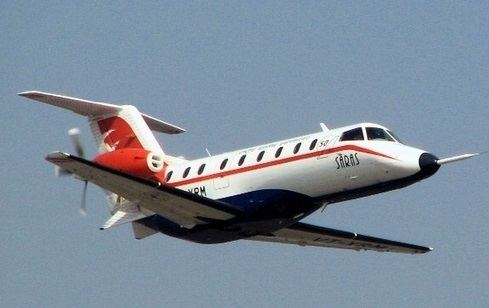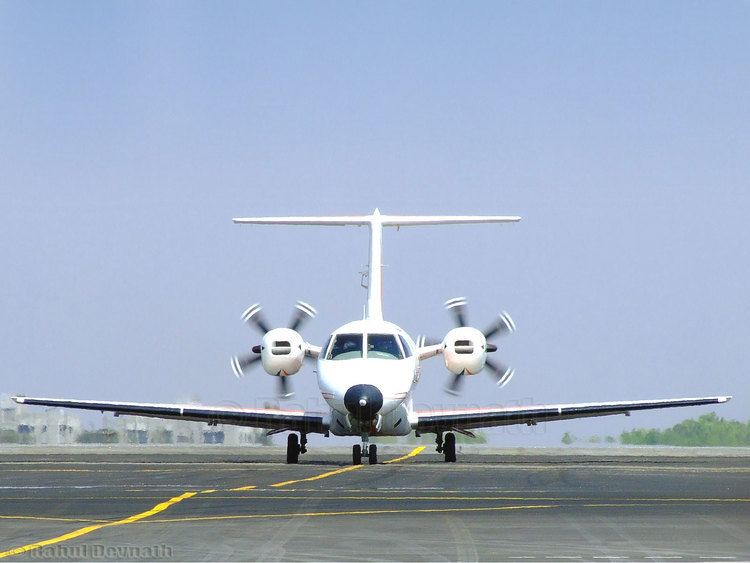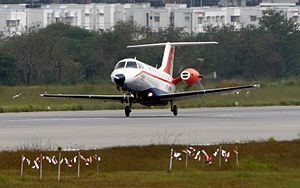Top speed 750 km/h Length 15 m | Wingspan 15 m First flight May 29, 2004 | |
 | ||
Manufacturers | ||
First flight of india s nal saras light multi utility aircraft
The NAL Saras (Sanskrit सारस: "Crane") is the first Indian multi-purpose civilian aircraft in the light transport aircraft category as designed by the National Aerospace Laboratories (NAL).
Contents
- First flight of india s nal saras light multi utility aircraft
- Design and development
- Current status
- Incidents and accidents
- Specifications Saras
- References

In January 2016, it was reported that the project has been cancelled. But in February 2017, the project has been revived.

Design and development

In the mid-1980s, the Research Council recommended that the NAL should study the civil aviation requirements of India and recommended ways of establishing a viable civil aviation industry. It further recommended that the NAL should carry out a formal techno-economical feasibility study of a multi role light transport aircraft (LTA – renamed SARAS in October 1993). The feasibility study (November 1989) showed that there was a significant demand for a 9–14 seat multi-role LTA in the country and estimated a market potential of about 250–350 aircraft in the next 10 years. NAL submitted the feasibility study report to the Research Council in November 1990 and started its search for an industrial partner.

The project began in 1991 as a collaboration with Russia (Myasishchev had a similar project called the Duet), but financial trouble led the Russians to drop out early in the project. The project almost came to a halt when it was hit by US-imposed sanctions in 1998, after India's nuclear tests in Pokhran. The Saras project was sanctioned on 24 September 1999 with initial schedule of its maiden flight by March 2001.
The original design target parameters included a maximum take-off weight of 6,100 kg and a maximum payload of 1,232 kg, a high cruise speed of over 600 km/h, an endurance of six hours, a maximum flight altitude of 12 km (cruise altitude 10.5 km), short take-off and landing distances of about 600 m, a maximum rate of climb of 12 m/s, a low cabin noise of 78 dB, a range of 600 km with 19 passengers, 1,200 km with 14 passengers and 2,000 km with eight passengers, a high specific range of 2.5 km/kg and a low cost of operation of ₹ 5/km.
The first Saras (PT1) completed its maiden flight at the HAL airport in Bangalore on 29 May 2004.
While the designed empty weight of the aircraft is around 4,125 kg, the first prototype weighed in around 5,118 kg. This issue is sought to be addressed by including composite wings and tail by the third prototype. The airframe of Saras-PT2 was built with lighter composites to reduce its overall weight by about 400 kg from its first prototype, which was overweight by about 900 kg. The aircraft is powered by two Canadian Pratt & Whitney turbo-prop engines.
Current status
The first prototype will be upgraded to meet the latest design criteria including higher-power 1,200 hp (895 kW) Pratt & Whitney Canada PT6A-67A engines and improvements to the flight control and flight operations systems. The upgraded PT1 is due to make its first flight by the end of 2011 leading to certification and first deliveries in 2013 and 2014 respectively.
The IAF has signed up with National Aerospace Laboratories, Bangalore for the purchase of 15 Saras aircraft. “NAL signed a memorandum of understanding with IAF to sell 15 Saras aircraft. The Kanpur unit of Hindustan Aeronautics Ltd will manufacture these planes,” The 14-seater twin-engine aircraft would be used for coastal surveillance as well as training young cadets on transport flying. The second prototype of the aircraft is overweight by 500 kg against the specified design weight of 4125 kg. The third prototype has yet to take flight.
As of 20 January 2016 National Aeronautics Limited (NAL) has stopped all work on Saras as the funding for the project stopped by end of 2013. Engineers who were working on NAL Saras got redeployed to other ongoing similar projects with higher strategic importance.
NAL is hoping to revive funding for the project. In October 2016, it was reported that government is mulling a revival plan. The Council for Scientific and Industrial Research (CSIR), that had almost shelved the plan, is on a rethink mode with additional funding in the pipeline.[1]
As of Feb 14 2017, reconfigured first prototype has just been handed over to the IAF’s Aircraft & Systems Testing Establishment (ASTE), which has conducted a few low-speed ground runs. The National Aerospace Lab’s (NAL) director Jitendra J. Jadhav is said to be looking at putting the Saras back into the air by June–July, though officers on the programme seem to think August–September was a more likely timeframe.
Incidents and accidents
On 6 March 2009, 2 Indian Air Force test pilots, Wing Commander Praveen Kotekoppa and Wing Commander Dipesh Shah along with a Flight Test Engineer Squadron Leader Ilayaraja, were killed when the second prototype Saras aircraft crashed and caught fire in an open field near Bidadi, about 30 km from Bangalore. A court of inquiry found that wrong engine relight drills given to the pilots contributed to the crash, concluding that an "Incorrect relight procedure devised by the designer and adopted by the crew at insufficient height leading to rapid loss of altitude and abnormal behaviour of aircraft resulted into accident."
Specifications (Saras)
General characteristics
Performance
Avionics
integrated digital avionics system using ARINC 429 data bus interfaces
